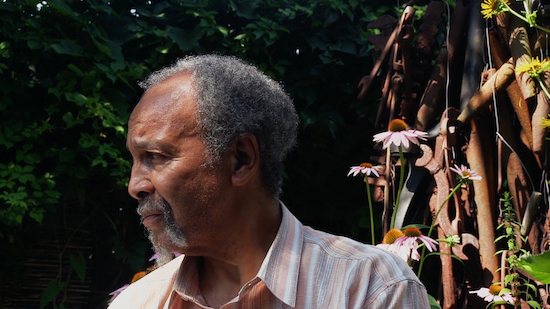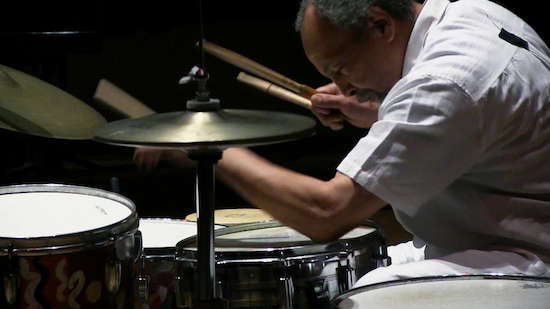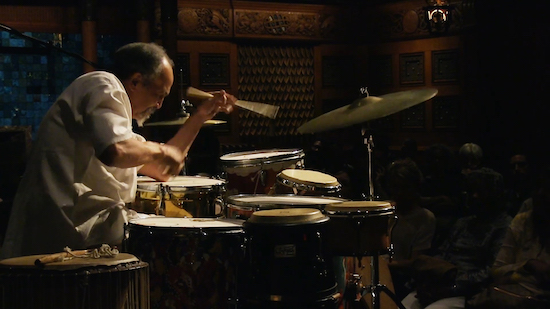Milford Graves Full Mantis, a new documentary about the jazz musician and polymath, is an exquisite music film and an example of how vital documentaries about music, art, life and the creative process are when created with passion and imagination.
The film, directed by Jake Meginsky and co-directed by Neil Young does, as Geeta Dyal wrote in her 4Columns review, “pulse with energy” – but it is more than one. It is overflowing with various, life-affirming energies. The energies and rhythms the film captures and explores work in confluence and harmony, seemingly disparate as they convey Milford’s fascination and experimentations in plant life, martial arts, tear ducts, the heart and family but continually tied through the jazz and electronic music that is central to what is not only one of the best music documentaries of recent times, but potentially one of the best, period.
The film is not a linear biography. Like Meginsky himself, Graves’s student of fifteen years, the film revels in spending time in the drummer’s company listening to him and gleaning wisdom from his experience as a musician and citizen of the natural, embodied world. It contextualises many of the various threads of Milford’s teachings that he shares in the film through incredible archive footage – both still and moving – along with a respectful and thorough engagement with Milford in his home environment, where many of his experiments with biorhythms, botany, and martial arts practice are centred.
The film feels rooted in cinema, as director Jake Meginsky alludes to in the interview below, through the way it constructs specific contexts of time and space, sound, the past and present, around Milford. The film feels like a product of the time and access Meginsky had to his subject. They met when Graves taught at Bennington College where Meginsky was his lab assistant. When Graves retired Meginsky went with him to his house in Queens where he continues to study and where much of the film is set. He considers himself Graves’s lifelong student and lucky to have found a great teacher. Graves is lucky to have found such a sympathetic and fascinated cinematic biographer.
One of the many triumphs of the film is also how connected it is to Meginsky’s own music practice. The musician, who releases minimalist electronic music under his own name and under the moniker Vapor Gourds uses the themes and structures of jazz and electronic music to create a flow and texture to the film that aligns the content with the form of Graves’s and Meginsky’s own musical journeys in a poetic way still frustratingly rare in music documentary.

The film has screened so far at SXSW, Doc/Fest and the Film Society of Lincoln Center’s Art of the Real season, at the BFI on Monday 9 July with an introduction from fan Thurston Moore, at HOME in Manchester as part of the Manchester International Jazz Festival ‘Jazz on Film’ season. Ahead of further engagements Jake Meginsky talked about being a student, making his first film and the influence of everything from Les Blank to Italian post-war modernist cinema.
The opening title card, with the quote by Milford about experiencing, not analysing, felt like your directive to the film’s audience:
Jake Meginsky: The quote serves multiple purposes in the structure. It’s related to a great story that Milford told me about transitioning into playing Avantgarde music and finding himself in situations where he was performing for audiences who may not have had exposure to that kind of music before. He would be playing in a church or a community centre where people would be coming for other things than music or the music was popular music and he was experiencing in the early to mid 1960s different kinds of angry reaction to what he was doing. He decided he would do a lithograph, which we couldn’t find, which said something like “what’s about to happen, you don’t need to understand it fully, just take it in, it’ll be over in 45 minutes and you can take it with you and do what you want with it”. He would put that out on every seat, with a piece of mint leaf, or something to smell. He found that after he did that, the reaction of the audiences would totally change and he’d get a lot of people coming up to him saying they’d never heard anything like that and they appreciated it.
That quote, was also something he said to me and I’ve heard him say to other people in different forms about how it can be overwhelming when you come to Milford’s house, but just look at the insects, take a look at the basement, at the dojo, don’t try to analyse it.
It is also directive to the audience to put them in a more parasympathetic nervous system state, as Milford would put it, so you aren’t watching to see and right away think about what you’re getting and not getting. Just allow the images and sounds to come in.
I would also say it became a directive for making the film too, it became about just being present to both the experience of turning the camera on, of being his student, and learning to project less and less of my own ideas onto the material and just listen to the material itself, see what it was and let it tell me what it wanted be.
There are a lot of formal attributes to the film. There’s a sequence at the start where he’s almost like silent film performer, lots of different ‘experimental’ techniques, which felt responsive from you as a filmmaker. That can be quite a risky strategy though. Did you ever think about doing something more traditional or where you just thinking about what you wanted to do and what you felt the film needed, not worrying about how people would take it?
I don’t think I thought about any of that stuff. We never thought about whether it was risky or not, it was just about letting the film be what it wanted to be. The formal elements of the film, whether they read as experimental or not, served a logical function in the film itself. The film felt like it needed to be dancing with Milford and conforming to his energy as a teacher and the energy of his music. It needed to be with Milford always so the journey of the film became figuring out how that works filmically and visually.
That comes across. Superficially the elements of the music and the garden and the dojo all seem disparate but because of Milford and his presence and your relationship as filmmakers with him it all feels connected. There is a real sense of ease in terms of being guided through the film, which is hard to do and is a testament to the collaboration between you, Milford, and Neil Young (co-director, cinematographer). How did the process work?
I’ve been Milford’s student for 15 years. I’ve been recording him for about that long so the film is intertwined with that relationship. It started very early. There’s audio in the film that was recording about 15 years ago. I became his student in 2004 and started recording him that year. For my own use as a student, with his permission. I could sense that what he was talking about was dynamic enough that I needed to have repeated listens. I made CDs or mixtapes with the music and his voice. Over time I would help out by recording things that he had going on like a film about his garden for a lecture he was giving on biology at Harvard. Pretty soon there was a couple of hard drives of material. It was around six or seven years ago that he started sharing his archive with me, stuff that no one had seen before.
I’ve always been a cinephile, although this is my first film, and the thing that pushed me into thinking there was something cinematic here in this footage, was when he showed me the full reel of him with Min Tanaka in Japan, at the school for children with autism. It’s a 20 minute reel and we watched it on a super 8 projector projected on a wall. I had a full cinematic experience because that sequence has so much in it. It starts with the children quiet doing self soothing behaviour. The vibe in the music and the dancing changes in such a dramatic way over the 20 minute performance. There’s a shot of one of the children who is pulling at his hair at the beginning, coming over and standing in front of the drum set, dancing. There are these in-camera cuts that I left in. At that moment [watching the reel] I don’t know if I said it out loud to myself but I could see there was some serious cinema going on. We started talking about doing a film.
Other filmmakers came at different times and I saw them try to do something but they really weren’t in tune with Milford’s vibe. That’s when I started saying out loud that I was going to make a film. Then I just had to deal with the repercussions and the pressure of that and start work. It always had to do with being a student and I knew that at least for this film it was going to be about the core teachings that had the most effect on me and as the process got deeper it became about reflecting back the teachings that he’s given me that have been really profound but I also started to recognise by participating in this process that it was also about what he wanted to share most. Those were the two things that were in dialogue in terms of the film. I would continue to make mixtapes along the way, of his voice and his music, and sometimes something would pop out from his teaching that seemed to have its own gravity and sometimes visual ideas would come from that.

It’s amazing that it’s your first film, particularly in terms of the command of the narrative of the piece and its structure. It just feels right. For example, when Milford is telling the story about the incident with the gun and his son, the editing is a masterclass in pacing and it feels like a more formally traditional documentary sequence. You’ve mentioned you’re a cinephile so I wonder, when you realised that you had to be the one to make this film, if you had any reference films or filmmakers that you had in mind while you were working?
It’s all in there. Since it’s my first one I think you’re whole life of watching gets in there in some way, though you kind of see that after the fact. I come from music and improvisation, so the way I know how to make things is from that. Listening and allowing things the space and time to grow. My process is less about asserting a formal structure but let structure be an emergent process and reacting to it.
That being said, everything from devouring Shaw Brothers Kung Fu VHS tapes when I was younger. That way of looking at a teacher and then looking at an object on a wall, then back at the teacher. I see that in Five Deadly Venoms. The Shaw Brothers are like Hitchcock in that every shot has a specific function in how the film moves. You feel that strong hand in Shaw Brothers films that I love. Les Blank. Watching A Poem Is A Naked Person as it was re-released during the editing process [of my film] and seeing how it stays out of the way of musical sequences and letting a performance assert and reassert itself in different ways. I studied Italian Cinema so that way of looking at nature and architecture. It’s all in there. I knew I definitely didn’t want to take too much away from the energy of the music itself and the films about music that I love, like Les Blank’s Always For Pleasure, the abstraction of film and the editing starts to go into the musicality. I wanted to do something more like that than anything else but what was so fun about editing was being able to respond to the footage and ask it what it was. There were really interesting formal things that jumped out.
I was on a music residency in Sweden at the electronic music studio there and right near my Airbnb there was a Don Cherry exhibition with all the Swedish archive films of him, just playing on a loop. It was amazing. I would go on walks over there and not even go to my residency. I just faced off with the Milford hard drives and made some of the first cuts.
One of the first decisions was having that sequence you mentioned where Milford is almost doing his silent movie dance and playing the hand drums. Having him do that dance to applause from a concert from 40 years ago, something about it, about making a film about making art that was focused on the creative process but showed an artist as he was, which is someone for whom the past is constantly living, using editing techniques where the past and the present exist in a more circular way seemed very in tune with Milford.
This is where other filmmakers might have got flat footage, because Milford is not someone where you can go to his house and ask him straight out about about a record from 1964 and what was happening when it came out. He’s much more interested in inviting you to look at the sculpture he’s working on with a heartbeat machine hooked up to it. His garden, his dojo, his martial arts practice, his drumming. They’re all feeding each other. The past and the present work like that in his life too so to have them work like that in the film was a nice surprise and it made the editing interesting and fun, having the younger versions of Milford in dialogue with the present moment.
It feels very evident that there’s a musicality to the way the film is constructed, which ironically is quite rare in films about music. It makes sense with your background in electronic music and jazz that you would approach it that way. Both electronic music and jazz are forms that have circularity and orbit in them and orbiting feels pertinent when talking about Milford. He’s at the centre with all these things orbiting around him. There are motifs and through lines in the same way there are in those musical forms. A relationship between jazz and electronic music is oft cited but your film really draws out some of the ways those practices are connected.
If there was any goal, there was a sense of finding out if a film about music could do what music does. It’s about energy transfer. Great cinema does that but music films often don’t for some reason. It was about making sure in every cut energy was being transferred and putting the audience in the position where the most amount of energy from Milford is getting transferred. It’s putting the audience into the position of being an audience for the music but also in the position of learners. The film gives the opportunity to be a student.
…and think about how engagement with the wider world feeds the creative process. His music wouldn’t be as powerful or necessarily able to transfer that energy if he was only interested in music. His art is informed by his existence in the world and that is a great lesson that comes through in the film just by spending time with him.
One really special thing about Milford as a subject for a film is his almost scientist’s drive to explain his creative process and his creative process is clearly extremely complex and dynamic. He’s not cagey or protective. He’s filled with energy to share. That’s a rare thing for a musician. Milford’s music is challenging but what I’ve found from screening the film for lots of different types of audience who come with no context, even for jazz, is that they they sit there for 90 minutes realising that the expression you see him do in the early 1970s and do again in the 1980s and the 2000s is tied into gardening, and family life, and all sorts of human experiences. The art comes from his particular way of making sense of all of it and that’s an invitation for lots of different kinds of people to explore creative process. Milford’s cosmology is an inclusive one. It’s about recognising the power of your own sensorial experiences.
What has the experience of finishing the film and sharing it with audiences been like?
I’m glad we ended up doing 90 minutes and get to see Milford in the cinema. I kinda knew he was like a movie star, you referencing silent film was great because I have always seen that in him as a performer, you know, Buster Keaton. Seeing him in a full 200 seat cinema at say, The Light in Sheffield [where the films screened as part of this year’s Doc/Fest] on a huge screen ‘doing cinema’ is amazing. I’ve seen him do this for 15 years in a music context but there’s something magical about the lights turning down and people sharing in that experience with him.
What do you hope audiences take away from a film with so many profound and beautiful ideas contained within?
Throw away the metronome and listen to your heartbeat.
For information about future screenings of Milford Graves Full Mantis please check the film’s website


